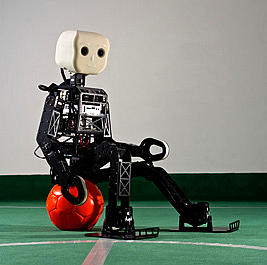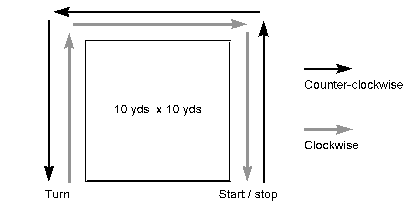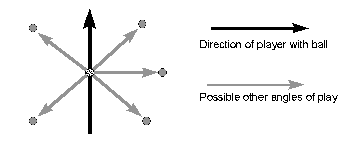| |
 |
PRESENCE LENDS CONVICTION
Preparing and Training…
by Douglas L. Semark
Former AYSO Director of Education
Used by Permission. Copyright © 1997 AYSO. All rights reserved.
Reproduced from a 1997 Section Meeting presentation
 |
Your presence on the field includes visual impressions, displays of
physical ability, proximity to play, and sound reading of proper
location and timing. In these cases, your body is the mechanism for
creating this presence.
Creating a Better Mechanism (Body) through Stretching
1. Foundation Posture (to prepare for proper stretching)
 -
Place feet hip width apart.
-
Place feet hip width apart.
 -
"Grab" the ground with the toes.
-
"Grab" the ground with the toes.
 -
Slightly relax and soften the knees.
-
Slightly relax and soften the knees.
 -
Pinch in buttocks to help place pelvic girdle in true horizon.
-
Pinch in buttocks to help place pelvic girdle in true horizon.
 -
Pull in abdomen.
-
Pull in abdomen.
 -
Place shoulders back, but don't over tighten them.
-
Place shoulders back, but don't over tighten them.
If possible, this is the desirable posture for most people. If pain or
discomfort occur, stop and see a doctor.
2. Active Stretches (using muscles that oppose those we want to stretch
-- no pain)
 - General leg: Lift leg about 45°, hold, then lower leg.
- General leg: Lift leg about 45°, hold, then lower leg.
 - Hamstring: Lift leg about 45°, then point toes toward knee; relax, then
lower leg.
- Hamstring: Lift leg about 45°, then point toes toward knee; relax, then
lower leg.
 - Achilles tendon: Lift leg about 45°; point toes, then pull toes upward
toward knee several times. Relax, then lower leg.
- Achilles tendon: Lift leg about 45°; point toes, then pull toes upward
toward knee several times. Relax, then lower leg.
 - Quadriceps: Place hands in small of back. Lift leg backward with knee
bent. Using only leg muscles (no hands), pull knee back as far as
possible while pointing toes toward knee. Relax, then lower leg.
- Quadriceps: Place hands in small of back. Lift leg backward with knee
bent. Using only leg muscles (no hands), pull knee back as far as
possible while pointing toes toward knee. Relax, then lower leg.
 - Upper body: Stretch arms wide, and as far back as comfortable. Slowly
pull them forward and cross them until the elbows bend and the hands can
"grab" the shoulders. Repeat, letting other arm cross on top.
- Upper body: Stretch arms wide, and as far back as comfortable. Slowly
pull them forward and cross them until the elbows bend and the hands can
"grab" the shoulders. Repeat, letting other arm cross on top.
3. Passive Stretches
 - Inner and outer leg: Stand on one leg, lift opposite foot backward and
drop hip. Hold position, then raise hip and lower foot.
- Inner and outer leg: Stand on one leg, lift opposite foot backward and
drop hip. Hold position, then raise hip and lower foot.
 - Hamstring: Keeping lower back stable, slowly stick buttocks out until
toes begin to come off ground. Move forward to foundation posture by
tightening hamstrings.
- Hamstring: Keeping lower back stable, slowly stick buttocks out until
toes begin to come off ground. Move forward to foundation posture by
tightening hamstrings.
 - Arms and upper body: Place hands low in front and lace fingers. Lift
until over head, then let go and bring hands and extended arms down and
out until they reach the sides of the body.
- Arms and upper body: Place hands low in front and lace fingers. Lift
until over head, then let go and bring hands and extended arms down and
out until they reach the sides of the body.
Strengthening and Tempering the Mechanism
4. Jog in Place to Warm Up (normally 2-5 minutes)
 -
Begin slow and easy, knees coming up slightly.
-
Begin slow and easy, knees coming up slightly.
 -
While slightly increasing pace, bring knees higher.
-
While slightly increasing pace, bring knees higher.
 -
Lift knees toward chest and kick up heels.
-
Lift knees toward chest and kick up heels.
  -
Slow down and stop.
-
Slow down and stop.
5. Jog/Run for Pace, Rhythm, and Speed
 -
From goal-line, run (do this using at least 60% speed) to goal-area line
(6 yard line), then jog back.
-
From goal-line, run (do this using at least 60% speed) to goal-area line
(6 yard line), then jog back.
 -
From goal-line, run to penalty-area line (18 yard line), then jog back.
-
From goal-line, run to penalty-area line (18 yard line), then jog back.
 -
From goal-line, run to half-way line, jog back.
-
From goal-line, run to half-way line, jog back.
 -
From goal-line, run to far penalty-area line, jog back.
-
From goal-line, run to far penalty-area line, jog back.
 -
From goal-line, run to far goal-area line, jog back.
-
From goal-line, run to far goal-area line, jog back.
 -
From goal-line, run to opposite goal-line, then continue around the
field varying speed and direction. Run backward and sideways (without
crossing legs) both left and right.
-
From goal-line, run to opposite goal-line, then continue around the
field varying speed and direction. Run backward and sideways (without
crossing legs) both left and right.
6. Jog for Flexibility

 -
Run the course counter-clockwise at 60% speed, then turn and run clockwise.
-
Run the course counter-clockwise at 60% speed, then turn and run clockwise.
 -
Run the course counter-clockwise at 80% speed, then turn and run clockwise.
-
Run the course counter-clockwise at 80% speed, then turn and run clockwise.
 -
Run the course counter-clockwise at variable speed, from slow jog to sprint, then turn and run clockwise.
-
Run the course counter-clockwise at variable speed, from slow jog to sprint, then turn and run clockwise.
Using the Mechanism
7. Soccer Position (a proper transitional posture
on the field)
 - Keep feet spread about shoulder-width apart.
- Keep feet spread about shoulder-width apart.
 - Keep weight forward on balls of feet, with heels on ground.
- Keep weight forward on balls of feet, with heels on ground.
 - Keep knees slightly bent.
- Keep knees slightly bent.
 - Keep hands relaxed and arms held slightly out from the sides.
- Keep hands relaxed and arms held slightly out from the sides.
 - Keep shoulders relaxed, neck flexible, and head mobile.
- Keep shoulders relaxed, neck flexible, and head mobile.
Each of these elements, or
variations of them, are essential foundations for increased quickness,
acceleration, and mobility.
8. Quickness (from a soccer position standing start)
 - Lead in the direction of the sprint with the hand and arm that
correspond with the leading foot.
- Lead in the direction of the sprint with the hand and arm that
correspond with the leading foot.
 - Allow the center of gravity to follow the lead of the hand and arm by
lifting the leading foot up off the ground, but do not place it on the
ground until the body has begun "falling" in the desired direction.
- Allow the center of gravity to follow the lead of the hand and arm by
lifting the leading foot up off the ground, but do not place it on the
ground until the body has begun "falling" in the desired direction.
 - Taking a very short stride, place the leading foot on the ground
behind the moving center of gravity, while the pushing (trailing) leg
extends the ankle, knee, and hip for maximum acceleration.
- Taking a very short stride, place the leading foot on the ground
behind the moving center of gravity, while the pushing (trailing) leg
extends the ankle, knee, and hip for maximum acceleration.
 - Concentrate on keeping the center of gravity moving in a straight
line, rather than up and down or side to side.
- Concentrate on keeping the center of gravity moving in a straight
line, rather than up and down or side to side.
 - Complete each successive stride with the foot meeting the ground
behind the center of gravity.
- Complete each successive stride with the foot meeting the ground
behind the center of gravity.
 - A more compact stride is better for control, agility, starting, and
stopping; a longer stride is good for straight ahead running.
- A more compact stride is better for control, agility, starting, and
stopping; a longer stride is good for straight ahead running.
Common errors include standing
flat-footed, miss-stepping in the wrong direction, raising the foot and
knee too high on the first step, not using the arms to help get the body
in motion, and holding the whistle and arms up and close to the body.
9. Turning (while moving at speed)
 - At the moment the turn is to be made, the leading leg must be extended
beyond the center of gravity, then bend at the ankle, knee, and hip to
reduce momentum.
- At the moment the turn is to be made, the leading leg must be extended
beyond the center of gravity, then bend at the ankle, knee, and hip to
reduce momentum.
 - As momentum ceases and the center of gravity begins to "rebound" from
its forward motion, the trailing leg and arm become the lead leg and arm
for transition to the new direction.
- As momentum ceases and the center of gravity begins to "rebound" from
its forward motion, the trailing leg and arm become the lead leg and arm
for transition to the new direction.
 - Extend the new lead arm to lead in the new direction.
- Extend the new lead arm to lead in the new direction.
 - Allow the center of gravity to follow the lead of the hand and arm by
lifting the leading foot up off the ground, but do not place it on the
ground until the body has begun "falling" in the desired direction.
- Allow the center of gravity to follow the lead of the hand and arm by
lifting the leading foot up off the ground, but do not place it on the
ground until the body has begun "falling" in the desired direction.
 - Taking a very short stride, place the leading foot on the ground
behind the moving center of gravity, while the pushing (trailing) leg
extends the ankle, knee, and hip for maximum acceleration.
- Taking a very short stride, place the leading foot on the ground
behind the moving center of gravity, while the pushing (trailing) leg
extends the ankle, knee, and hip for maximum acceleration.
Common mistakes include
overrunning by half a stride, ending up flat-footed with both feet
parallel, and turning away from play rather than with it.
10. Presence (being there and being seen without
being in the way)
 - At times when there is active play, be within 5-20 yards of play.
- At times when there is active play, be within 5-20 yards of play.
 - Usually, be behind play and away from the angles of attack.
- Usually, be behind play and away from the angles of attack.

 - At times when the ball is in the air or in transition, anticipate its
next probable location and move to within 20 yards of that spot.
- At times when the ball is in the air or in transition, anticipate its
next probable location and move to within 20 yards of that spot.
 - Depending on proximity of play, continue to run for a few strides even
though play slows down.
- Depending on proximity of play, continue to run for a few strides even
though play slows down.
 - If play borders on conflict, close on the spot to within five yards,
avoiding the angles of attack.
- If play borders on conflict, close on the spot to within five yards,
avoiding the angles of attack.
 - As much as possible, come to rest in the "soccer position" for a quick
response to changes. Try to keep the body "live" at all times during
play.
- As much as possible, come to rest in the "soccer position" for a quick
response to changes. Try to keep the body "live" at all times during
play.
 - As always, keep play between you and an assistant referee, and delay,
rotate around, and get behind play during transitions. Also, immediately
transition to the opposite side assistant referee.
- As always, keep play between you and an assistant referee, and delay,
rotate around, and get behind play during transitions. Also, immediately
transition to the opposite side assistant referee.
In addition to using your bodily mechanism as a means of
creating visual and proximate presence, think about aural presence,
legal presence, and emotional presence.
|